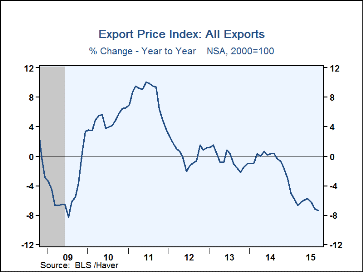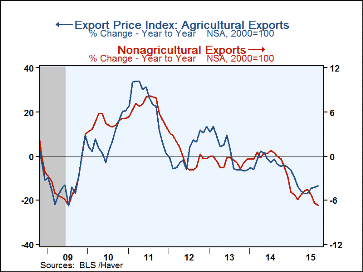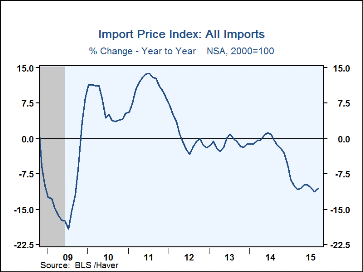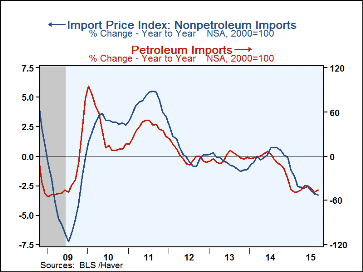 Global| Oct 09 2015
Global| Oct 09 2015U.S. Import Price Decline Is Limited By Rise In Petroleum Costs
by:Tom Moeller
|in:Economy in Brief
Summary
Import prices eased 0.1% during September (-10.7% y/y) following a revised 1.6% drop during August, revised from -1.8%. A 0.5% decline had been expected in the Action Economics Forecast Survey. A 1.1% increase (-46.1% y/y) in [...]
Import prices eased 0.1% during September (-10.7% y/y) following a revised 1.6% drop during August, revised from -1.8%. A 0.5% decline had been expected in the Action Economics Forecast Survey. A 1.1% increase (-46.1% y/y) in petroleum prices was the first rise in three months. Nonpetroleum import prices slipped 0.2% (-3.3% y/y). Prices have not risen m/m since March of last year. A 0.8% decline (-3.1% y/y) in foods, feeds & beverages costs led the total downward. Nonoil supplies & materials prices declined 0.6% (-10.6% y/y). Capital goods prices followed with a 0.1% dip (-2.3% y/y). Motor vehicle & parts costs remained unchanged (-1.4% y/y) but nonauto consumer goods prices edged 0.1% higher (-1.1% y/y), the first increase since February.
Export prices fell 0.7% (-7.4% y/y) following a 1.4% drop. Expectations had been for a 0.6% decline. A 1.7% shortfall (-17.1% y/y) in industrial supplies & materials prices led the way lower. This decline reflected lower fuels & building materials prices, without which prices fell 0.5% (-8.8% y/y). Foods, feeds & beverages prices fell 1.1% (-4.3% y/y) and nonauto consumer goods prices declined 0.2% (-2.8% y/y). Automotive vehicles & parts prices eased 0.1% (-0.3% y/y) and capital goods prices remained unchanged, both m/m and y/y.
The import and export price series can be found in Haver's USECON database. Detailed figures, including the industrial materials excluding petroleum imports and the petroleum export items mentioned above, are available in the USINT database. The expectations figure from the Action Economics Forecast Survey is in the AS1REPNA database.
The minutes to the latest FOMC meeting can be found here


| Import/Export Prices (NSA, %) | Sep | Aug | Jul | Sep Y/Y | 2014 | 2013 | 2012 |
|---|---|---|---|---|---|---|---|
| Imports - All Commodities | -0.1 | -1.6 | -1.0 | -10.7 | -1.1 | -1.1 | 0.3 |
| Petroleum | 1.1 | -11.8 | -6.6 | -46.1 | -5.6 | -2.6 | -0.3 |
| Nonpetroleum | -0.2 | -0.4 | -0.4 | -3.3 | 0.1 | -0.6 | 0.3 |
| Exports - All Commodities | -0.7 | -1.4 | -0.4 | -7.4 | -0.5 | -0.4 | 0.4 |
| Agricultural | -1.1 | -2.5 | 1.0 | -13.5 | -2.7 | 1.6 | 2.4 |
| Nonagricultural | -0.6 | -1.3 | -0.6 | -6.7 | -0.3 | -0.7 | 0.1 |
Tom Moeller
AuthorMore in Author Profile »Prior to joining Haver Analytics in 2000, Mr. Moeller worked as the Economist at Chancellor Capital Management from 1985 to 1999. There, he developed comprehensive economic forecasts and interpreted economic data for equity and fixed income portfolio managers. Also at Chancellor, Mr. Moeller worked as an equity analyst and was responsible for researching and rating companies in the economically sensitive automobile and housing industries for investment in Chancellor’s equity portfolio. Prior to joining Chancellor, Mr. Moeller was an Economist at Citibank from 1979 to 1984. He also analyzed pricing behavior in the metals industry for the Council on Wage and Price Stability in Washington, D.C. In 1999, Mr. Moeller received the award for most accurate forecast from the Forecasters' Club of New York. From 1990 to 1992 he was President of the New York Association for Business Economists. Mr. Moeller earned an M.B.A. in Finance from Fordham University, where he graduated in 1987. He holds a Bachelor of Arts in Economics from George Washington University.








